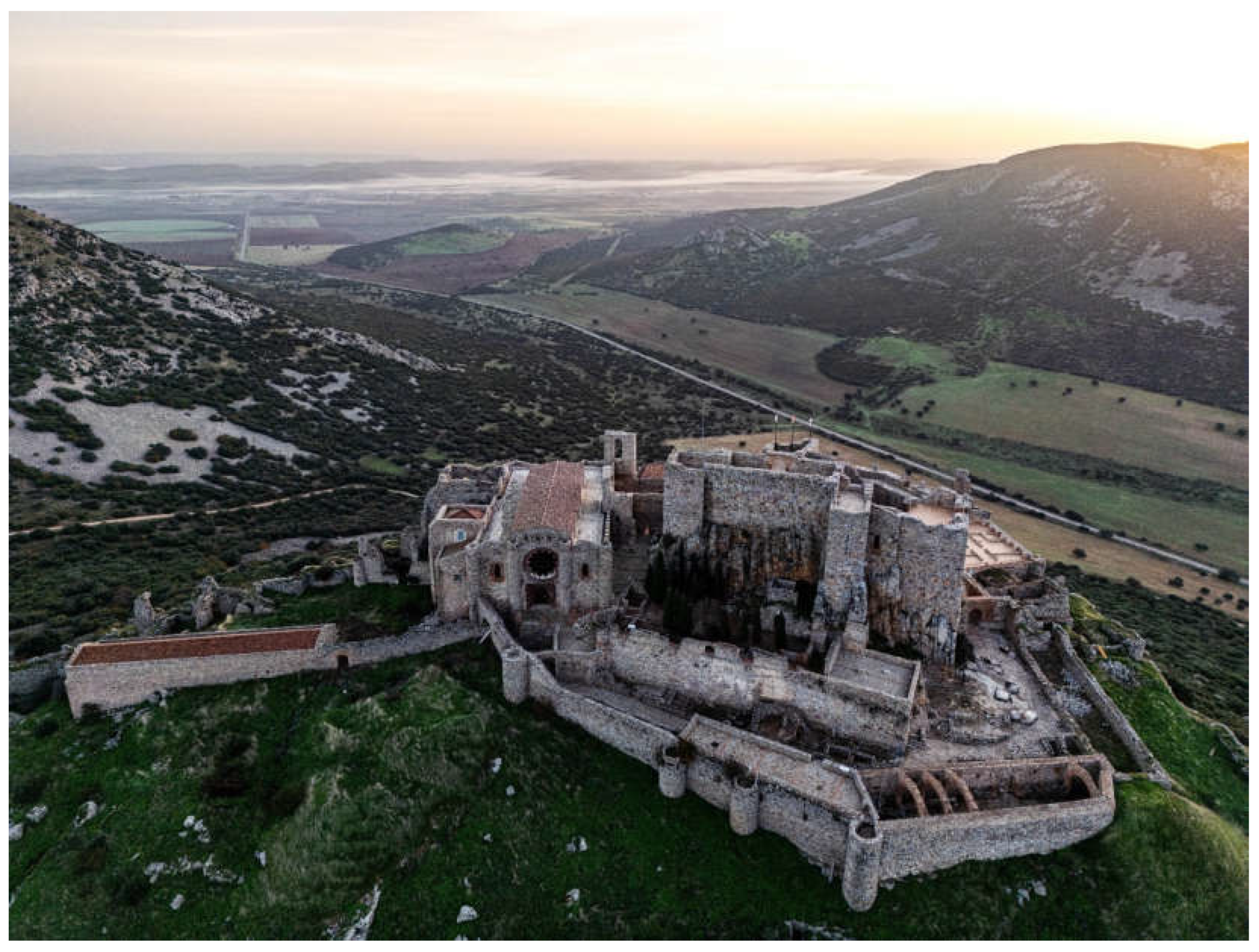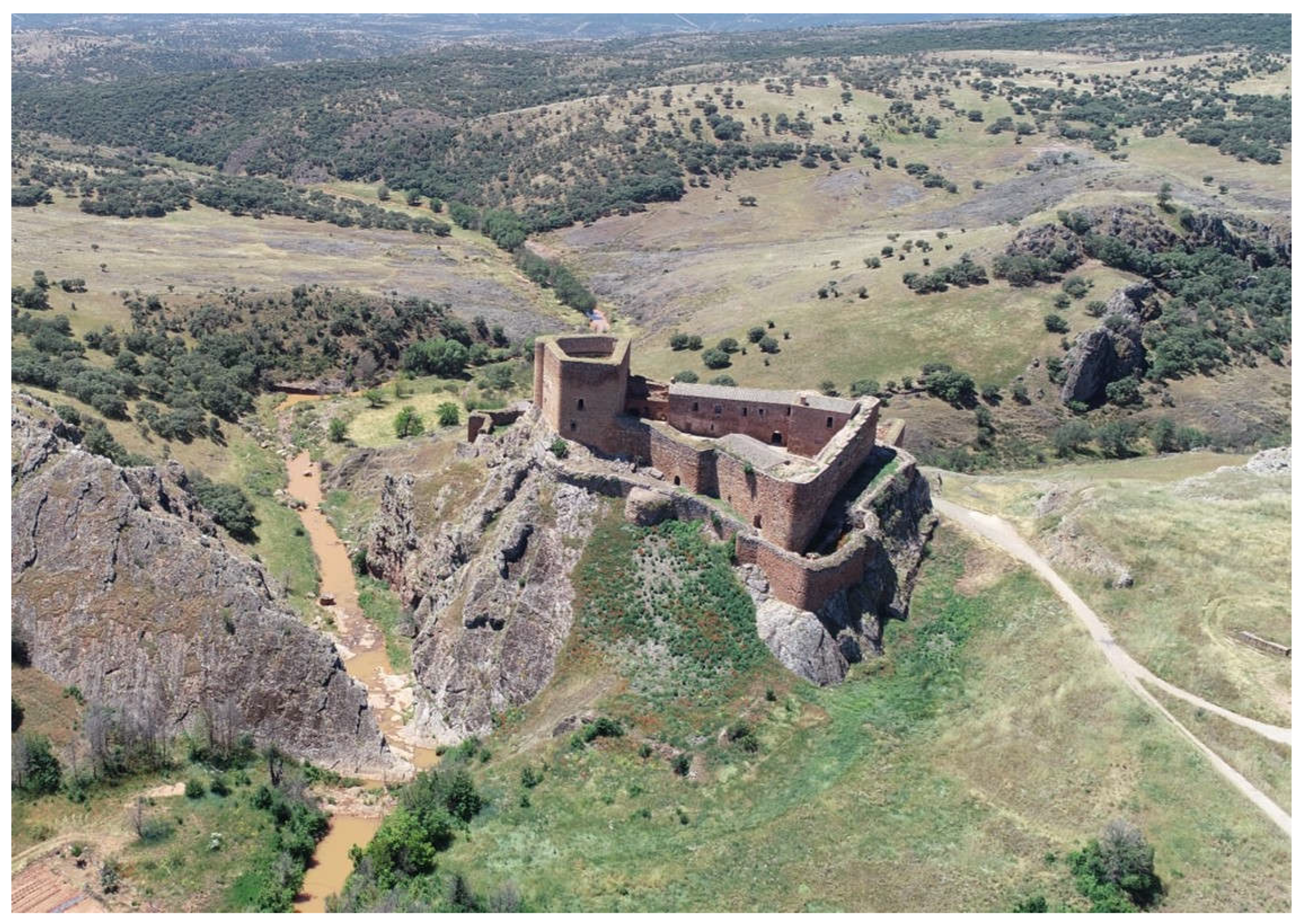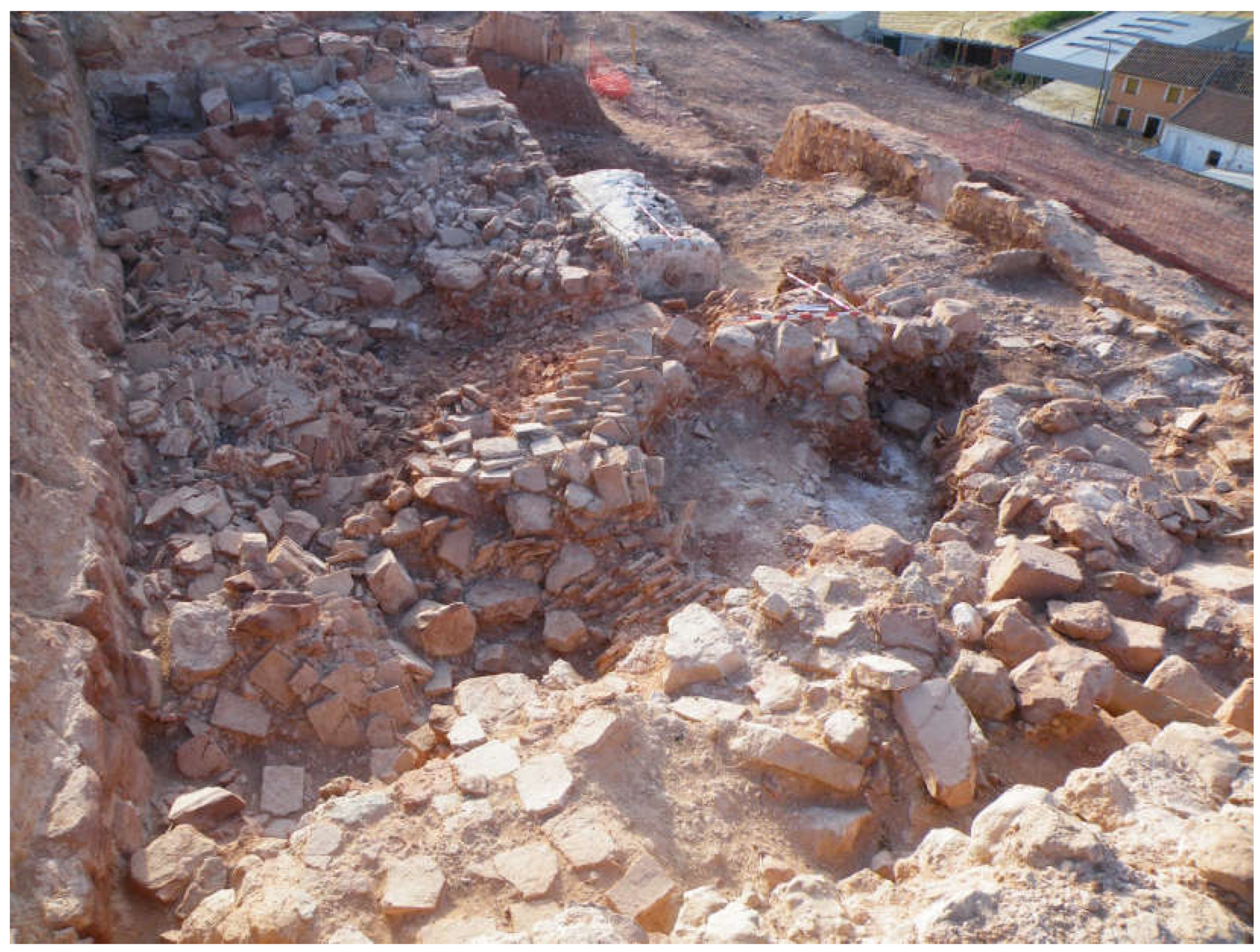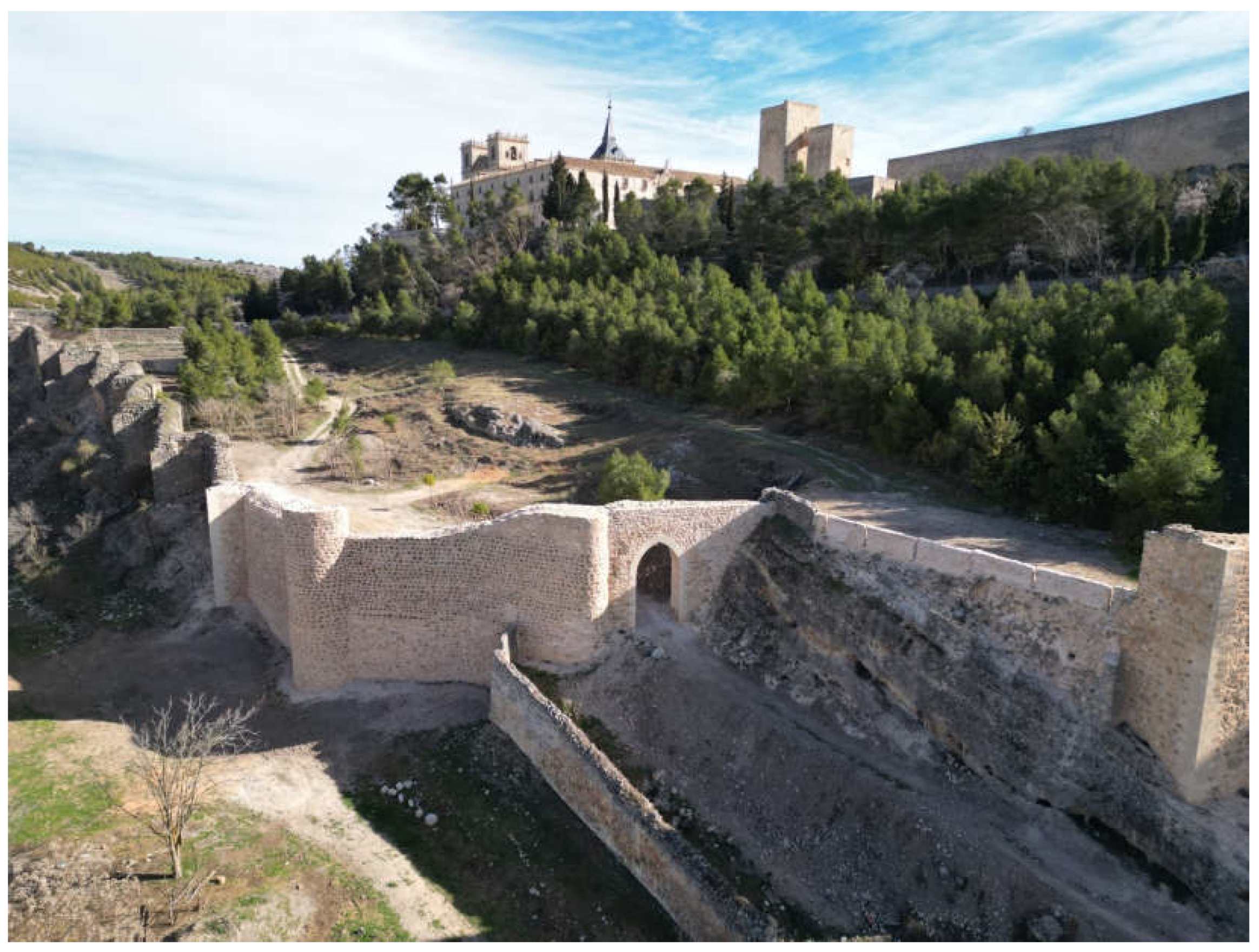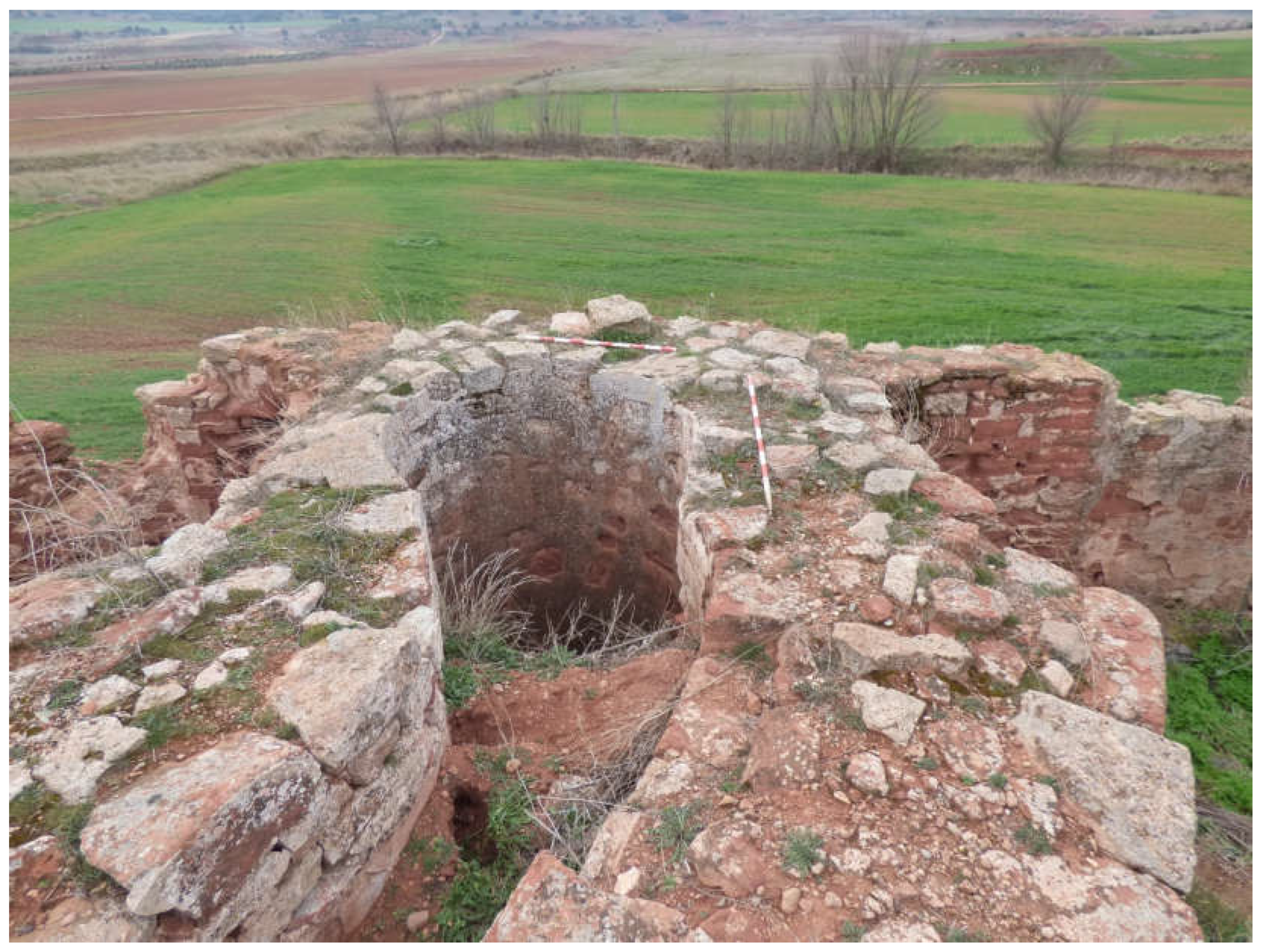In this sense, the Military Orders operated as construction enterprises, responsible for procuring the resources, organising the workshops, and guaranteeing the supply of materials for each of their projects. It is our belief that the construction systems and their procedures did not vary significantly between one Order and another, or with other contemporary seigniorial powers. However, it is possible to identify different distinctions and approaches depending on the territory and period, as well as the appearance of singular buildings such as castle-convents and houses of bastimento (warehouses).
One must acknowledge that written sources describing the methods of construction, especially in rural sectors such as those of the study area, are practically non-existent until the second half of the 15th century. This fact has greatly limited the current research and has led to hypotheses that were later found to be invalid. Bearing this limitation in mind, we believe that applying an appropriate methodology to the analyses of the materiality of these features (either emerging above ground level or unearthed by archaeological excavations) can offer sufficient information on their systems of construction. This type of evidence can shed light on a series of aspects including the approach to constructive projects, the materials required and how to procure them, the techniques to apply, and the professionals needed to perform the tasks.
3.1. The Presence of Master Builders and the Design of the Buildings
A first subject of focus when analysing the organisation of work, which is far from trivial and influences the rest of the process, is the planning of the design of the buildings. In the case of the Hispanic Military Orders, there is evidence that, during most of the Middle Ages, the figure of the
obrero mayor, the master worker charged with the supervision and commissioning of the constructions in the different territories, was not institutionalised as it was later at the dawn of the Modern Era (
Ayala Martínez 2007, p. 285). The absence of this figure meant that work orders were probably assumed either by local master builders, most likely Mudéjar, or a foreman engaged from a nearby city. This is the case for the important centre of Toledo which at the outset of the 13th century supplied a master builder to supervise the construction of the castle-convent of Calatrava La Nueva (
Zapata Alarcón 2015, p. 60) (
Figure 7). This individual was in a position to sign piecework contracts whose contents broadly specified the layout of the building, the necessary personnel, and the costs of the materials.
Evidence of the existence of these master builders in the earliest phases relies on information gathered from the archaeology of the architecture as written sources, such as the
Libros de Visita (visitation books) or lawsuits housed in the Judicial Archive of Toledo, only offer data subsequent to the second half of the 15th century (
Romero Fernández-Pacheco 2016, pp. 31–72). These sources are particularly rich in casting light on construction systems, contracts, workers, materials, etc. (
García-Carpintero López de Mota 2020), as noted in earlier research (on which we cannot dwell in detail here), especially that concerning the Castle of Montiel (
Gallego Valle and Molero García 2017, pp. 657–68). However, it is appropriate to highlight at least one example in the archives that refers to visitations in 1515 by members of the Order of Santiago to the Commandery of Montiel
1 (but in reference to an event of 1507) (
Figure 8). The case describes a lawsuit over the construction process that was financed by a
media anata imposed by the knight commander Gonzalo Chacón. The statements by witnesses cite the presence not only of
alarifes, but also of quarrymen and other tradesmen, in this case locals, who were under the tutelage of the general design of the
obrero mayor of the Order of Santiago. The lawsuit was eventually ‘papered over’ at the time and the commander was absolved of all blame, although note was made that he had not been as scrupulous with the accounts as he should have.
In spite of the absence of written documentation shedding light on the materiality of the constructions, it is evident the builders resorted to earlier guidelines to raise fortresses. This is deduced from the study on the distribution of the castle-houses of the commandery built by the Order of Santiago between the Sierra del Segura and Campo de Montiel between the end of the 13th century and the outset of the 14th century such as Montiel, Montizón (
Figure 9), and Segura itself (
Gallego Valle 2021, pp. 779–85). The design of these buildings, adapted to orographic constraints, adhered to a similar model marked by the predominance of an interior space with a keep, converted into the main symbol of the building, and a privative church of the Order, where there must have been interesting decorative programmes, but unfortunately, we only preserve very isolated fragments, either in the archaeological remains or in late written sources, mostly dating from the end of the 15th century. In addition, the measurements and typology of the floor plan of these towers, both quadrangular and semicircular, reveal practically identical proportions, a fact that cannot be coincidental.
Another theme evidenced by archaeological research but devoid of clear input from written texts is whether these master builders had notions of poliorcetics or not. Clearly fundamental to any military enclosure is the choice of location, the general plan, the arrangement of the towers and wall sections, the shooting features, etc. It is thus obvious that these
maestros must have either possessed sufficient notions of military engineering to undertake the project or benefitted from precise direct advice. Indeed, plans of castles had to take into account the distance between towers to channel attackers into kill zones. Access to them also evolved as their entrances became more complex with the adoption of an elbow-shaped layout (
Molero García et al. 2021, pp. 205–34). It is possible that the planning was carried out by the knights commanders or
freires who were responsible for the fortresses (
Ayala Martínez 2007, p. 271), as one can perceive that they adopted solutions resulting from their experience, incorporating not only Christian traditions but features acquired from their foes on the other side of the border, especially during the Christian expansion into the Guadalquivir Valley.
Leaving aside the fortresses, one cannot rule out the presence of master builders in the construction of temples. However, the participation of
obreros mayores is only confirmed by written records related to the great undertakings of the 15th and early 16th centuries (
Molina Chamizo 2006, pp. 380–81). It is likely that the Orders themselves counted on experienced master builders who moved around their territories, a system known in other seigniorial domains. Hence, in this sense, there appears to be no clear evidence of differences between the different territories. We have accordingly identified buildings in certain uninhabited areas, such as Guadalajara, bearing Romanesque layouts that are very similar to those from more northern lands (
Salgado Pantoja 2021). These stonework temples, raised during the 13th century, followed a design characterised by one to three naves ending in semicircular apses. Examples include those in the villages of the Santiago Order around Uclés and Montiel (
Figure 10) and the Church of the Order of the Hospital of Arenas de San Juan. These seem to have been very similar to those documented in other territories under the control of the Military Order (
Gerrard 2006;
Perez Monzón 1999).
The presence of Mudéjar
alarifes, in some cases called
maestros, is confirmed in the domains of both the Orders of Santiago and Calatrava. Their hand is noted in religious buildings and in the methods of building fortresses, notably in the paradigmatic castle-convent of Calatrava La Nueva (
Zapata Alarcón 2015, pp. 53–69). Their participation can also be confirmed by the fortresses of Montiel and Uclés not only for the first centuries but also later in the 15th century by references to individuals such as Martin Marchina and Ibrahim el Moro
2. Here and elsewhere these
maestros reveal a unique know-how of different construction techniques and materials, ranging from stone to bricks, distancing the traditional image of these professions (
Borrás Gualis 1990, pp. 101–5).
3.2. Techniques, Materials, and Trades
The participation of other professionals ranking below the master builders must have been common in the territories of the different Military Orders. Quarrymen, alarifes, and even carpenters at times took charge of the works depending on the technique and level of difficulty. As noted above, although written records are scarce or non-existent for most of this study’s chronological timeframes, the materiality of the structures offers ample information as to both the individuals who participated in their construction and the entire system applied to the task.
An involvement of
alarifes is obvious when it comes to small and medium-sized military enclosures and temples, where the greatest technical difficulty was raising the vaults and laying the stonework (
García Mansilla 2003, pp. 7–15). Therefore, one of these professionals serving to direct the operations and carry out the most qualified work presumably sufficed. At the same level, and in many cases combining both tasks in the same person, were carpenters charged with collecting and working all the wood used to fashion the falsework for vaults, scaffolding, and roofs. Both they and the
alarifes were also often charged with the design and assemblage of the devices, most often serving to hoist heavy loads, systematically put to use at the construction sites (
Cómez Ramos 2009, p. 117).
A paradigmatic case in point, the focus of our archaeological and architectural research of recent years (
Molero García et al. 2022, pp. 16–35), pertains to the construction processes of the vaults of certain unique buildings of Military Orders from the 13th and early 14th centuries. Their detailed analysis suggests the presence of crews of specialists, either Mudéjar or Christian, who relocated from site to site. The findings also indicate that the vaults were not fashioned with falsework but by joining of courses of stones of different morphologies, a technique that could only be applied after raising the walls. This technique resorting to staggered work phases thus sped up the operation. Examples are the Calatrava La Nueva (first half of the 13th century), the tower of the Grand Prior of Alcázar de San Juan (late 13th century), and, with data from archaeological excavations, the 13th-century churches in Montiel (Nuestra Señora de La Estrella and Santiago) (
Figure 11).
At a lower rank were the other workers, such as quarrymen, who were assigned to provide the stone that was extracted either at the construction site itself or transported from nearby quarries (
Cómez Ramos 2009, p. 120). It is conceivable that
alarifes charged with the construction extracted the stone themselves. There are records indicating that these professionals throughout the lands controlled by the Military Orders were essential in raising the walls of different types. These walls were made of ashlars or formwork or, more commonly, of parallel rows of stone raised like parapets whose interiors were packed with a fill of stone rubble bonded with lime mortar. This technique, observed during the excavation of the western wall of the Estremera quarter of Uclés, and confirmed by petrological analyses, allowed different crews led by professionals to rapidly and simultaneously raise different sections of the wall.
This type of work demanded a massive amount of stone that was extracted from different types of quarries (
Gómez Canales 2008, p. 50). Knowledge of these exploitations has advanced thanks to archaeological research. Pottery continues to be fundamental in their dating. When abundant and combined with domestic structures they suggest the presence of a nucleus of a settlement of varying types that could survive over time by supplying stone to various localities. This required the building of roads, sources of water to cut the stones, and space to extend the quarry faces. An example is the hill of Las Canterillas to the north of Uclés, which still bears traces of limestone extraction as well as wedge holes used to extract the large blocks. Moreover, archaeometric studies of this site link its materials with those of the walls of Uclés (
Figure 12).
In other cases, due to their location on high rocky summits, the outcrops themselves served as quarries. Although there are countless examples, we cite here the case of the Castle and Church of Torres (Cumbres de San Bartolomé, Huelva). The practically inaccessible position of the building, on the peak of a mountain, led the Order of St. John to resort to the veins of quartzite and slate at hand. The research we conducted on this castle and its surroundings indicates that stones were extracted simultaneously to the digging of the ditch. However, as this material did not suffice, the outcrops from the surroundings had to be exploited so as to yield medium and small-sized blocks. The extraction debris was later crushed and used as aggregate, an action observed, for example, in the construction of the Church of the Castle of Eznavexor (Villamanrique).
There is evidence of the existence of specialised stonemason crews, such as those dedicated to extracting and cutting the stone, who were often charged with specific elements of the construction. Their main tasks are reflected in the extraction of blocks for hollowed features, stairs, and corners, which were subsequently marked (
Gómez Canales 2008, p. 48). The presence of specialised stonemasons is constant in the different buildings of the Military Orders from the end of the 13th century as evidenced by the towers of Alcázar de San Juan, Terrinches, and Génave. These structures, which formed part of larger enclosures, bear numerous mason marks. It must be noted that in many cases these symbols served as guides to place the blocks and should not be confused with other stone graffiti (calvaries, stars, checker boards, alquerques).
Records evidencing the work of specialised stonemasons are not limited to temples and large fortresses but include smaller features, such as watermills scattered along the main rivers crossing the domains of the Military Orders (
Matellanes Merchán 1999, p. 514). Our investigation of the Vicario Mill of Montiel (
Gallego Valle and Molero García 2016) (
Figure 13) has revealed the process the stonemasons applied to its construction. These observations are complimented by references to the mill in the visitation books of 1478
3, which describe investments and repairs to its infrastructure. In any case, it is clear that the mill house was raised with large ashlars despite the loss of many to looting. Of particular interest is the construction of its mill race and vertical penstock which resorted to perfectly squared blocks.
Tapiadores, specialists in raising rammed earth walls (
Graciani García 2009, pp. 109–41), perhaps associated with a carpenter, were presumably a fixture in these construction sites (
Cómez Ramos 2009, p. 72). Our research has recorded many cases of rammed earth walls raised with earth and masonry (or mixed), in many cases adapted to local resources. An example is the rammed earth wall preserving its surface crust at the Castle of Santa María del Guadiana (Argamasilla de Alba) (
Figure 14). Rammed quicklime walls using gypsum such as that of the Church of Belmontejo (Horcajo de Santiago) are common to the area of Cuenca. The use of rammed earth was constant throughout the Sierra del Segura. These features are at times mistaken for Islamic works, as is the case of the walls of Segura or Hornos, as well as those of the inaccessible Castle of Espinareda.
Another lesser known group of individuals linked to construction consisted of the suppliers (
Palomo Fernández 1999, p. 132). These included makers of quicklime, plaster, bricks, and tiles and blacksmiths, who potentially, beside their normal work, could have also directly participated in the works. Either these types of products were acquired locally in a finished state or orders were given to stockpile them at points belonging to the promoter, an option that is more in line with the cases of this study. In the area around Montiel, for example, our archaeological surveys recorded brickworks, lime kilns, and zones where earth was extracted to construct the buildings of the town and castle. Many of these features are located in the Jabalón River Valley at the foot of the site. Others such as the stockpiles of sand, in turn, had to be procured several kilometres away.
The peonage, the most basic members of the labour force consisting of a very heterogeneous group of individuals, is rarely cited in written records. The group firstly consisted of day labourers whose involvement was not always constant but contracted for fixed periods to carry out specific tasks. The group likewise included contingents of occasional operatives who, due to seigniorial or regional obligations, were required to provide their services for a certain number of days. Examples are the peasants residing on the lands owned by the Military Orders, normally linked to border
fueros (regional charters) such as that of Cuenca (
Rodríguez-Picavea Matilla 2008, p. 356). In this group one must also include Mudéjar contingents enslaved subsequent to the great conquests of the 13th century (
Zapata Alarcón 2015, p. 58) and to the constant clashes along the border. Decisive in this sense were the Mudéjars in the territories under the Military Orders, especially that of the Order of Santiago, deported from Murcia and Lower Andalusia to Castile and subjected to servitude after the revolt of 1264.
One must also highlight, albeit in a general manner, a persistent attendance of women in these architectural processes throughout the Middle Ages (
Rabadé Obradó 1988, pp. 114–15). They, in fact, formed part of the group of day labourers tasked with transporting materials, carrying out demolitions, and serving as auxiliary personnel in quarries. They were likewise specialised in certain trades, such as the production of lime mortars (
Borrero Fernández 2001, pp. 97–122), where they earned salaries equal to that of their male counterparts. The data from other territories point to their engagement, for example, in various large-scale ventures (
Figure 15), such as in the erection of the Cathedrals of Toledo and Burgos, and in repairs to Valencian castles (
García Mansilla 2003, pp. 8–9). Women also worked in various projects under the Order of Santiago such as the repair of the mills belonging to the Hospital of Cuenca (
Sánchez Ayuso 2009, vol. 2, p. 367).
To conclude this brief incursion into the personnel mobilised for these constructions we turn to the issue of their salaries. Without advancing a general overview of the subject, already carried out by other researchers (e.g.,
Cómez Ramos 2009, pp. 71–76), it is possible to specify that compensation for the days and tasks varied considerably from one geographical area to another. These were particularly high in Andalusian lands, especially for specialists of quarry work. The best paid were the
alarifes and the master builders, at a rank above the carpenters and quarrymen. The promoter could reimburse them in different manners, either by cash or in the form of exemptions of taxes.
3.3. Financing the Buildings of the Military Orders
Due to the scarcity of the records from the 12th to the early 15th century, it is difficult to address the source of the funds that the various Military Orders of the Middle Ages had at their disposal to erect their different buildings. The visitation books cited above that yield information on the works, their costs, materials, contracts, and the individuals or institution responsible for the payments, in fact, only became systematic during the second half of 15th century. There are nonetheless, in the case of certain fortresses, various references, mostly indirect, that offer approximate responses to this question.
Research on the financing of fortresses of the Military Orders (
Ayala Martínez 2007, pp. 575–90;
Rodríguez-Picavea Matilla 2008, pp. 159–67) revealed that the expenses for their owners were broken down into three main types: construction and repairs, payments of the wages of the garrison, and maintenance of the supplies. It is the first of the three, construction and repairs, that is of interest to the current study. Moreover, it was this aspect that presumably represented the greatest investment. This is based on archaeological research which offers evidence that a great number of fortresses were raised simultaneously along different fronts during the conquest and repopulation of the territory.
Although the income available to the militias to finance these undertakings varied, most consisted of direct donations from the monarchs (
Rodríguez-Picavea Matilla 2008, p. 162). A compelling case from the outset of the 13th century is that of the will of Alfonso VIII (1204) who annually granted no less than 10,000
maravedis for a period of 10 years to the construction of the Castle of Salvatierra. This fortification at the time served as seat of the Calatrava Order and acted as the spearhead of the conflict of the Kingdom of Castile with the Almohad Caliphate. This figure contrasts with the 4000
maravedis reserved for the Castle of Uclés and the 2000
maravedis for the works of the Castle of Consuegra, seats respectively of the Orders of Santiago and St. John in the Kingdom of Castile. In any case, the will evidences the direct intervention of the crown in these early stages of their building. There is no doubt that these expenses were also covered by donations from large open farmlands and other earnings for the first concessions of castles to the Military Orders. There are records suggesting this in the areas of the Campo de Calatrava and in the neighbouring Campo de San Juan, most notably in reference to what is known as the ‘four castles of the Upper Guadiana’ positioned along the banks of this river (ca. 1215) (
Molero García 2016, pp. 103–34).
From the second half of the 13th century, especially during the reign of Alfonso X, the monarchy ceded certain ecclesiastical benefits to the Military Orders, such as the
tercias (a share of the tithe) (
Rodríguez-Picavea Matilla 2008, p. 162). A well-known case revolved around the Castle of Osuna where the Castilian-Leonese monarch offered the
tercias collected from the churches of the town to help finance the construction of the fortress. It is our belief that this type of funding also took place in other territories. The masters at this time, through their various incomes, by means of
retenencias (supplies and other articles necessary for the maintenance and defence of a fortress), would allocate the economic resources to the commanders to cover the costs of the construction and maintenance of the fortresses (
Ayala Martínez 2007, p. 582).
Earnings apart from the religious sources also stemmed from military activity against the Muslims. Benefits could be received, for example, from the preaching of crusades by certain military enterprises or the raising of funds to maintain the castles along the border, in particular those related to the Guerra del Estrecho and to the reign of Alfonso XI. To this type of funding can also be added to contributions collected from individuals in the form of pious donations.
Secular income was also secured in the form of royalties from the crown. Income deriving from livestock throughout the area of La Mancha was presumably fundamental to this process. This concerned especially the collection of
montazgos and
portazgos, tolls imposed for the passage of animals and people that certainly generated significant benefits due to the continuous north/south transit of livestock (
Ruiz Gómez 2003). Also linked to livestock were revenues collected by the Orders from allowing animals to pasture on their lands and from holding of fairs such as that observed continuously in Montiel since 1252. Other income potentially derived from municipal obligations such as those noted in the
fueros related to the defence and maintenance of the towns (
Palacios Ontalva 2008, p. 352). Another very clear example were the funds from numerous royalties and monopolies offered by the crown, in times of need, for the works associated with the Castle of Consuegra. This project in 1173 received the revenues collected from the tolls imposed on pack animals transiting from the Christian territory towards the Sierra del Segura. Years later, in 1200, in the face of the Almohad threat, it was awarded a large sum stemming from exploiting the salt mines of Belinchón, which increased, four years later, with the delivery cited above of 2000
maravedis over a period of ten years (
Molero García 2005, pp. 331–76).
Although there is no explicit reference in the written records of the exploitation of the territory’s resources and certain monopolies by the Military Orders, they must have served to cover a variety of expenses. In this regard, one cannot dismiss the income gained from renting mills and bakeries or the trade of certain products, such as those extracted from the sandstone quarries of Alhambra. These since ancient times were known both for their whetstones and for their refractory blocks serving to build specific features of bakeries and smithies (
Sánchez Ayuso 2009, vol. 2, p. 307).
Despite all these sources of revenue, there is evidence in the 15th century of a serious drawback linked to the lack of liquidity to cover the great expenses related to the maintenance of castles. This problem, not exclusive to the territories of Military Orders, affected the neighbouring Kingdom of Valencia, where maintaining the castles was so costly that their owners themselves often voluntarily demolished them. Although these circumstances bear a certain logic concerning the castles in the rear, it also often affected those raised along the border with the Sultanate of Granada (
Molero García 2014b, pp. 133–40). The ongoing attacks and the demographic debility along this border meant that they were unprofitable for the Military Orders as they required a continuous transfer of assets from possessions in the rear (
Ayala Martínez 2007, pp. 561–602).
Leaving aside the military constructions that, due to the multitude of data, have monopolised the discourse of this study, the (Military Orders allocated significant revenues to the erection of other features intended to gain earnings either through rent or through entities linked to seigniorial administration, notably mills, bakeries, and the houses of the commandery. Visitation books since the end of the 15th century offer extensive information on these properties, which were subjected to continuous repairs that should have been covered by the commanderies. This resulted in many lawsuits both due to the idleness of the knights commanders and to their lack of funds, leading them to often resort to the
mesa maestral to finance the works (
García-Carpintero López de Mota 2022, pp. 358–64).
Finally, we would like to briefly delve into the issue of religious buildings. Normally, in the case of parishes, the councils themselves were responsible for their construction. Although these were financed with their revenues, funding also often came from private donors (
Molina Chamizo 2006, pp. 368–69). The financing of buildings designed to be used exclusively by the Orders (monasteries, convents, and churches or chapels built inside castles) did not vary significantly from that of the fortresses. Hermitages and hospitals attached to councils had to be paid for by these institutions, although it is usual for them to have been founded and maintained by brotherhoods and often by private donors.






